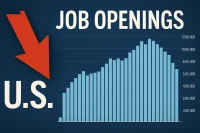Meta has unveiled plans for a groundbreaking project that will reshape the future of global internet connectivity.
Known as Project Waterworth, the tech giant aims to build the world’s longest subsea cable, stretching a remarkable 50,000 km (31,000 miles) across five continents.
This ambitious initiative promises to revolutionize data transfer and support Meta’s expanding reach in areas like artificial intelligence (AI) and global infrastructure.
Connecting the World: A Technological Leap
Meta’s subsea cable project will link several key regions, including:
- The United States
- India
- South Africa
- Brazil
- Australia (among others)
The cable will stretch across the oceans, providing unprecedented connectivity to these regions. It is expected to become the world’s longest underwater cable once completed.
rFimRGxEf%aFECbQ
The Role of AI and Infrastructure
Meta, the parent company of Facebook, Instagram, and WhatsApp, has sought to extend its influence beyond social media.
One key area of focus is AI, which requires substantial infrastructure to function efficiently. The new subsea cable will help facilitate these AI projects, allowing Meta to continue its technological innovations.
Project Waterworth is designed to support “industry-leading connectivity” by enhancing digital services and data transmission worldwide.
Meta envisions the cable as a major contributor to economic cooperation and digital inclusion across the regions it connects.
A High-Capacity System
Meta’s cable system will feature a 24 fibre-pair configuration, significantly boosting its capacity.
This allows for faster, more reliable data transfer, which is essential for the growing digital demand across the globe. With over 95% of the world’s internet traffic traveling through undersea cables, the project is poised to have a significant impact on global connectivity.
This cable will surpass even previous major projects in scale.
For comparison, the 2Africa cable, backed by Meta and several telecommunications companies, covers 45,000 km and connects three continents.
Hiring? Post jobs for free with WhatJobs
A Competitive Move in the Tech Industry
Meta’s bold move signals its growing ambition to control more of the digital infrastructure space.
Paolo Pescatore, a telecommunications market analyst, said Meta “has shown a strong desire to own more of the connectivity slice”.
Speaking to the BBC, he said:
“This is a further demonstration as it seeks to leapfrog rivals in providing users with an unique experience by tightly integrating hardware, software, platform and its growing aspirations in connectivity.
“Ultimately these moves, while welcome from an investment perspective, will raise further eyebrows among regulators and other key stakeholders given increasing dominance of big tech.”
This will give the company a competitive edge, enabling it to offer a more seamless and integrated user experience.
However, this dominance does not come without its concerns.
As Meta tightens its grip on global digital infrastructure, regulators and industry stakeholders may raise alarms about its increasing influence.
The Growing Need for Secure Subsea Cables
Subsea cables are critical to global communications.
With increasing reliance on these cables, there’s also a growing awareness of their vulnerabilities.
Recent incidents, such as severed cables and geopolitical tensions, have highlighted the need for more robust security measures.
Meta’s Project Waterworth plans to address these risks by:
- Laying the cable as deep as 7,000 meters underwater.
- Using advanced burial techniques to protect the cable in high-risk areas, such as shallow waters near coastlines, where ship anchors and other hazards could cause damage.
The project’s focus on security is crucial in a time when subsea cables are considered a key area for geopolitical conflict.
NATO, for instance, has increased surveillance of subsea cable routes following several incidents of damage.
There is growing concern over potential attacks from nations like Russia and China, especially during periods of political tension.
What’s Next for Meta?
Meta’s ambitious Project Waterworth is a clear signal that the company is not just a social media titan—it is positioning itself as a major player in global digital infrastructure.
As subsea cables continue to play a vital role in our interconnected world, Meta’s multi-billion-dollar investment is set to transform how the internet functions, making it faster and more reliable.
While this project brings new opportunities, it also raises questions about the concentration of power in the hands of big tech companies.
What will this mean for competition, privacy, and global cybersecurity?
As Meta continues to push the boundaries of what’s possible, the answers to these questions will likely shape the future of the internet.
Need Career Advice? Get employment skills advice at all levels of your career
Key Takeaways:
- Project Waterworth will be the world’s longest subsea cable, connecting five continents.
- The cable will support Meta’s growing AI infrastructure and enhance global connectivity.
- Security measures are being prioritized to safeguard the cable against potential threats.
- Meta’s investment highlights its ambition to control more of the digital infrastructure sector, raising concerns about its increasing dominance.
As Meta moves forward with this groundbreaking project, its impact on the digital world will likely be felt for years to come.




